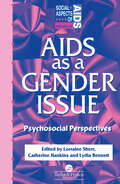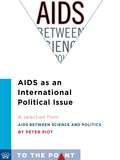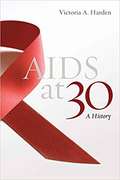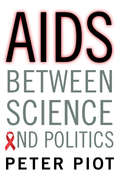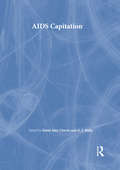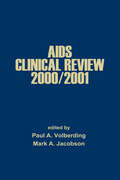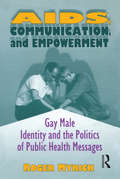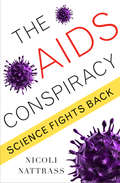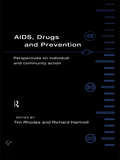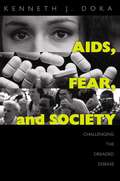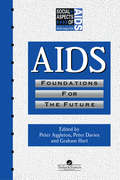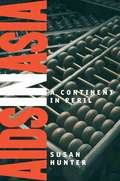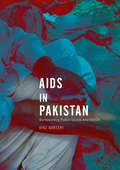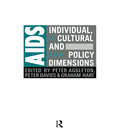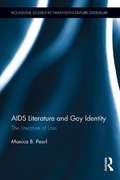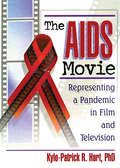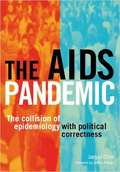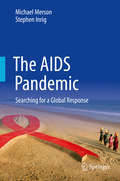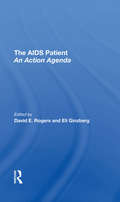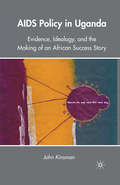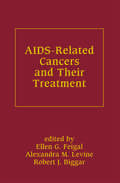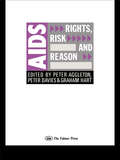- Table View
- List View
AIDS as a Gender Issue: Psychosocial Perspectives (Social Aspects of AIDS)
by Lorraine Sherr Catherine Hankins Lydia BennettThis international collection examines a wide range of psycho-social aspects of AIDS and HIV infection, including prevention, education, healthcare and policy in terms of gender challenges.
AIDS as an International Political Issue: A Selection from AIDS Between Science and Politics (To the Point)
by Peter PiotPeter Piot, founding executive director of the Joint United Nations Programme on HIV/AIDS (UNAIDS), reports on the influence of civil society in international relations and traditional partisan divides. AIDS thrust health into national and international politics where, he argues, it rightly belongs. The global reaction to AIDS over the past decade is the positive result of this partnership, showing what can be acheved when science, politics, and policy converge on the ground. Piot describes funding mechanisms for AIDS, the first international declarations, the response of the UN system, the establishment of UNAIDS, the response of high income countries to AIDS, The Global Fund and PEPFAR as game-changers, and lessons for other health problems.
Aids At 30: A History
by Victoria A. HardenSociety was not prepared in 1981 for the appearance of a new infectious disease, but we have since learned that emerging and reemerging diseases will continue to challenge humanity. AIDS at 30 is the first history of HIV/AIDS written for a general audience that emphasizes the medical response to the epidemic.Award-winning medical historian Victoria A. Harden approaches the AIDS virus from philosophical and intellectual perspectives in the history of medical science, discussing the process of scientific discovery, scientific evidence, and how laboratories found the cause of AIDS and developed therapeutic interventions. Similarly, her book places AIDS as the first infectious disease to be recognized simultaneously worldwide as a single phenomenon.After years of believing that vaccines and antibiotics would keep deadly epidemics away, researchers, doctors, patients, and the public were forced to abandon the arrogant assumption that they had conquered infectious diseases. By presenting an accessible discussion of the history of HIV/AIDS and analyzing how aspects of society advanced or hindered the response to the disease, AIDS at 30 illustrates for both medical professionals and general readers how medicine identifies and evaluates new infectious diseases quickly and what political and cultural factors limit the medical community’s response.
AIDS Between Science and Politics: A Selection From Aids Between Science And Politics (To The Point Ser.)
by Peter PiotPeter Piot, founding executive director of the Joint United Nations Programme on HIV/AIDS (UNAIDS), recounts his experience as a clinician, scientist, and activist fighting the disease from its earliest manifestation to today. The AIDS pandemic was not only catastrophic to the health of millions worldwide but also fractured international relations, global access to new technologies, and public health policies in nations across the globe. As he struggled to get ahead of the disease, Piot found science does little good when it operates independently of politics and economics, and politics is worthless if it rejects scientific evidence and respect for human rights. <P><P>Piot describes how the epidemic altered global attitudes toward sexuality, the character of the doctor-patient relationship, the influence of civil society in international relations, and traditional partisan divides. AIDS thrust health into national and international politics where, he argues, it rightly belongs. The global reaction to AIDS over the past decade is the positive result of this partnership, showing what can be achieved when science, politics, and policy converge on the ground. Yet it remains a fragile achievement, and Piot warns against complacency and the consequences of reduced investments. He refuses to accept a world in which high levels of HIV infection are the norm. Instead, he explains how to continue to reduce the incidence of the disease to minute levels through both prevention and treatment, until a vaccine is discovered.
AIDS Capitation
by David A CherinDiscover effective strategies for AIDS healthcare!You’ll definitely want to see what’s documented inside AIDS Capitation if you’re affiliated in any way with current efforts to bolster and improve healthcare policies and procedures for AIDS victims and their families. With this scholarly, up-to-date guidebook, you’ll find that your awareness and knowledge base concerning contemporary AIDS healthcare issues will expand and diversify, giving you a more stable information base from which you can make your own policy changes and civic organization improvements.If you’re a practitioner in HIV/AIDS care, an academic in HIV/AIDS research, or one of the many public officials currently involved in healthcare reform, you’ll find the guidance and proven strategies you need in AIDS Capitation. AIDS Capitation gives you a broad range of information including: descriptive and evaluative aspects of the model of care directions for implementing an innovative model of terminal home care modalities of care in end-stage treatment measurement issues in evaluative research help in measuring outcomes in community-based care funding opportunitiesWithout a doubt, the onset of HIV/AIDS has changed the way we view life. Our schools, government offices, and healthcare venues must change also. AIDS Capitation has everything you need to begin that process of change in your community.
AIDS Clinical Review 2000/2001 (Aids Clinical Review)
by Paul A. Volberding Mark A. JacobsonThe latest in the crucial series documenting scientific discoveries at the forefront of HIV and AIDS research!This volume updates the most important and controversial issues facing physicians, nurses, microbiologists, pharmacists, and epidemiologists who deal directly with patients suffering from HIV and AIDS, focusing on specific areas in which important new advances have occurred in diagnosis, therapy, and prevention of infection and related complications.Outlines new disease management strategies being tested in prospective clinical trials and observational studies!Combining elements of virology, epidemiology, immunology, oncology, endocrinology, neurology, psychiatry, and the behavioral sciences, AIDS Clinical Review 2000/2001clarifies substantive advancements in vaccine development, realistically assessing potential efficacy and limitations explores short-term antiretroviral therapy for dramatically reducing the rate of vertical transmission from mother to child evaluates the efficacy of antiretroviral prophylaxis for workers who experience high-risk exposure to HIV-infected blood discusses preservation of HIV specific immunity when antiretroviral therapy is initiated early in the course of acute infection considers complex drug interactions that occur when drugs are used in combination highlights cytokine and other immune-based therapies suggests chronic hepatitis may ultimately be more fatal than HIV for coinfected patients and more!Including results recently presented at scientific meetings but not yet published in peer-reviewed journals, AIDS Clinical Review 2000/2001 is essential reading for infectious disease specialists, epidemiologists, virologists, immunologists, pharmacologists, microbiologists, hematologists, hepatologists, oncologists, neurologists, medical students in these disciplines, and all medical professionals involved in both AIDS.
AIDS, Communication, and Empowerment: Gay Male Identity and the Politics of Public Health Messages
by Roger MyrickAIDS, Communication, and Empowerment examines the cultural construction of gay men in light of discourse used in the media’s messages about HIV/AIDS--messages often represented as educational, scientific, and informational but which are, in fact, politically charged. The book offers a compelling and substantive look at the social consequences of communication about HIV/AIDS and the reasons for the successes and failures of contemporary health communication. This analysis is important because it provides a reading of health communication from a marginal perspective, one that has often been kept silent in mainstream academic research. AIDS, Communication, and Empowerment offers a critical, historical analysis of public health communication about HIV/AIDS; the ways this communication makes sense historically and culturally; and the implications such messages have for the marginal group which has been most stigmatized as a consequence of these messages. It covers such topics as: the relationship among gay identity, language, and power cultural studies of the historical development of gay identity studies in health communication about HIV/AIDS and health risk communication the political consequences of public health education about HIV/AIDS on gay men the political consequences of media representations of gay identity and its relationship to disease Based primarily on the French scholar Michel Foucault’s critical, historical analysis of discourse and sexuality, this book takes a timely and original approach which differs from traditional, quantitative communication studies. It examines the relationship between language and culture using a qualitative, cultural studies approach which places medicalization theories in the broader context of histories of sexuality, the discursive development of contemporary gay identity, and recent public health communication.Author Roger Myrick explains how mainstream communication about HIV/AIDS relentlessly stigmatizes and further marginalizes gay identity. He describes how national health education stigmatizes groups by associating them with images of disease and “otherness.” Even communication which originates from marginal groups, particularly those relying on federal funds, often participates in linking gay identities with disease. According to Myrick, government funding, while often necessary for the continuation of community-based health campaigns, poses obvious and direct restrictions on effective marginal education. AIDS, Communication, and Empowerment allows for a rethinking of ways marginal groups can take control of their own education on public health issues. As HIV/AIDS cases continue to rise dramatically among marginalized and disenfranchised groups, analysis of health communication directed toward them becomes crucial to their survival. This book provides valuable insights and information for scholars, professionals, readers interested in the relationship among language, power and marginal identity, and for classes in gay and lesbian studies, health communication, or political communication.
The AIDS Conspiracy: Science Fights Back
by Nicoli NattrassSince the early days of the AIDS epidemic, many bizarre and dangerous hypotheses have been advanced to explain the origins of the disease. In this compelling book, Nicoli Nattrass explores the social and political factors prolonging the erroneous belief that the American government manufactured the human immunodeficiency virus (HIV) to be used as a biological weapon, as well as the myth's consequences for behavior, especially within African American and black South African communities.Contemporary AIDS denialism, the belief that HIV is harmless and that antiretroviral drugs are the true cause of AIDS, is a more insidious AIDS conspiracy theory. Advocates of this position make a "conspiratorial move" against HIV science by implying its methods cannot be trusted and that untested, alternative therapies are safer than antiretrovirals. These claims are genuinely life-threatening, as tragically demonstrated in South Africa when the delay of antiretroviral treatment resulted in nearly 333,000 AIDS deaths and 180,000 HIV infections—a tragedy of stunning proportions.Nattrass identifies four symbolically powerful figures ensuring the lifespan of AIDS denialism: the hero scientist (dissident scientists who lend credibility to the movement); the cultropreneur (alternative therapists who exploit the conspiratorial move as a marketing mechanism); the living icon (individuals who claim to be living proof of AIDS denialism's legitimacy); and the praise-singer (journalists who broadcast movement messages to the public). Nattrass also describes how pro-science activists have fought back by deploying empirical evidence and political credibility to resist AIDS conspiracy theories, which is part of the crucial project to defend evidence-based medicine.
The AIDS Conspiracy: Science Fights Back
by Nicoli NattrassSince the early days of the AIDS epidemic, many bizarre and dangerous hypotheses have been advanced to explain the origins of the disease. In this compelling book, Nicoli Nattrass explores the social and political factors prolonging the erroneous belief that the American government manufactured the human immunodeficiency virus (HIV) to be used as a biological weapon, as well as the myth's consequences for behavior, especially within African American and black South African communities. Contemporary AIDS denialism, the belief that HIV is harmless and that antiretroviral drugs are the true cause of AIDS, is a more insidious AIDS conspiracy theory. Advocates of this position make a "conspiratorial move" against HIV science by implying its methods cannot be trusted and that untested, alternative therapies are safer than antiretrovirals. These claims are genuinely life-threatening, as tragically demonstrated in South Africa when the delay of antiretroviral treatment resulted in nearly 333,000 AIDS deaths and 180,000 HIV infections -- a tragedy of stunning proportions. Nattrass identifies four symbolically powerful figures ensuring the lifespan of AIDS denialism: the hero scientist (dissident scientists who lend credibility to the movement); the cultropreneur (alternative therapists who exploit the conspiratorial move as a marketing mechanism); the living icon (individuals who claim to be living proof of AIDS denialism's legitimacy); and the praise-singer (journalists who broadcast movement messages to the public). Nattrass also describes how pro-science activists have fought back by deploying empirical evidence and political credibility to resist AIDS conspiracy theories, which is part of the crucial project to defend evidence-based medicine.
AIDS Doctors: An Oral History
by Ronald Bayer Gerald M. OppenheimerToday, AIDS has been indelibly etched in our consciousness. Yet it was less than twenty years ago that doctors confronted a sudden avalanche of strange, inexplicable, seemingly untreatable conditions that signaled the arrival of a devastating new disease. Bewildered, unprepared, and pushed to the limit of their diagnostic abilities, a select group of courageous physicians nevertheless persevered. This unique collective memoir tells their story. <p><p> Based on interviews with nearly eighty doctors whose lives and careers have centered on the AIDS epidemic from the early 1980s to the present, this candid, emotionally textured account details the palpable anxiety in the medical profession as it experienced a rapid succession of cases for which there was no clinical history. The physicians interviewed chronicle the roller coaster experiences of hope and despair, as they applied newly developed, often unsuccessful therapies. Yet these physicians who chose to embrace the challenge confronted more than just the sense of therapeutic helplessness in dealing with a disease they could not conquer. They also faced the tough choices inherent in treating a controversial, sexually and intravenously transmitted illness as many colleagues simply walked away. Many describe being gripped by a sense of mission: by the moral imperative to treat the disempowered and despised. Nearly all describe a common purpose, an esprit de corps that bound them together in a terrible yet exhilarating war against an invisible enemy. <p> This extraordinary oral history forms a landmark effort in the understanding of the AIDS crisis. Carefully collected and eloquently told, the doctors' narratives reveal the tenacity and unquenchable optimism that has paved the way for taming a 20th-century plague.
AIDS, Drugs and Prevention: Perspectives On Individual And Community Action
by Tim Rhodes Richard HartnollAIDS, Drugs and Prevention brings together a range of international contributions on the research, theory and practice of developing community-based HIV prevention. It aims to understand how individual actions to prevent HIV transmission are constrained and encouraged by situational and social context. Drawing on ethnographic and epidemiological research among populations of drug users, sex workers and gay men, it explores how future HIV prevention interventions can target changes at the level of the individual as well as at the level of the community and wider social environment. AIDS, Drugs and Prevention offers practical and theoretical insights into community-based health work in the time of AIDS. It provides invaluable reading for students, lecturers, researchers and practioners in health promotion, health policy, social work and medical sociology.
AIDS Drugs for All:
by Ethan B. Kapstein Joshua W. BusbyDrawing on a rich set of interviews and surveys, this book shows how the global AIDS treatment advocacy movement helped millions in the developing world gain access to life-saving medication. The movement achieved this by transforming the market for AIDS drugs from one which was 'low volume, high price' to one based on access for all. The authors suggest that a movement's ability to transform markets depends upon whether: (1) markets are contestable; (2) they have framed their arguments to resonate across their target audiences; (3) the movement itself has a coherent goal; (4) the costs are low, or the benefit-to-cost ratio is favourable; and, finally, (5) institutions are present to reward continued achievement of the new market principle. These insights are applied to a range of other cases including malaria, maternal mortality, water/diarrheal disease, non-communicable diseases, education, climate change, the ivory trade, sex trafficking and the Atlantic slave trade.
AIDS, Fear and Society: Challenging the Dreaded Disease (Death Education, Aging and Health Care)
by Kenneth J. DokaFirst Published in 1997. Routledge is an imprint of Taylor & Francis, an informa company.
AIDS: Foundations For The Future (Social Aspects of AIDS)
by Peter Davies Peter Aggleton Graham HartHIV and AIDS have posed new challenges to societies, communities and individuals. In many parts of the world, existing health and social services have been hard pressed to cope with the dermands of the epidemic. In hospitals and in the community, new approaches to health education, support and care have been developed. Non-governmental and community organizations have had a central role to play in responding to the challenge of HIV and AIDS. AIDS: Foundations for the Future highlights progress made over the last decade, and offers an agenda for future activism and research. This book examines the extent to which sound foundations for the future have been laid in public, private and voluntary sector action. It focuses on topics as diverse as workplace policy on HIV and AIDS, voluntary sector responses, the reactions of health care workers, the experience of living with AIDS, outreach work and community action, patterns of male prostitution, and new interventions to promote and maintain safer sex and safer drug use.
AIDS in Asia
by Susan HunterAIDS in Asia provides a thorough introduction to the social and economic issues surrounding the AIDS epidemic in Asia including: * Geographic obstacles to health care* Gender inequality and human trafficking* Political turmoil and poor leadership* Asia's role in the sex and drug trade* Economic conditions and exploitation At the crucial moment when the spread of AIDS in this region is beginning to gain worldwide recognition, distinguished expert Susan Hunter makes clear the catastrophic threat AIDS poses to Asia and the world, and draws on her experience to discuss the potential policy implications.
AIDS in Pakistan: Bureaucracy, Public Goods and NGOs
by Ayaz QureshiThis book is the first full-length study of HIV/AIDS work in relation to government and NGOs. In the early 2000s, Pakistan's response to HIV/AIDS was scaled-up and declared an area of urgent intervention. This response was funded by international donors requiring prevention, care and support services to be contracted out to NGOs - a global policy considered particularly important in Pakistan where the high risk populations are criminalized by the state. Based on unparalleled ethnographic access to government bureaucracies and their dealings with NGOs, Qureshi examines how global policies were translated by local actors and how they responded to the evolving HIV/AIDS crisis. The book encourages readers to reconsider the orthodoxy of policies regarding public-private partnership by critiquing the resulting changes in the bureaucracy, civil society and public goods. It is a must-read for students, scholars and practitioners concerned with neoliberal agendas in global health and development.
AIDS: Individual, Cultural And Policy Dimensions (Social Aspects of AIDS)
by Peter Aggleton Peter Davies Graham HartFirst Published in 1990. Routledge is an imprint of Taylor & Francis, an informa company.
AIDS Literature and Gay Identity: The Literature of Loss (Routledge Studies in Twentieth-Century Literature)
by Monica B. PearlThis book discusses the significance of late twentieth century and early twenty first century American fiction written in response to the AIDS crisis and interrogates how sexual identity is depicted and constructed textually. Pearl develops Freudian psychoanalytic theory in a complex account of the ways in which grief is expressed and worked out in literature, showing how key texts from the AIDS crisis by authors such as Edmund White, Michael Cunningham, Eve Sedgwick – and also, later, the archives of The ACT UP Oral History Project - lie both within the tradition of gay writing and a postmodernist poetics. The book demonstrates how literary texts both expose and construct personal identity, how they expose and produce sexual identities, and how gay and queer identities were written onto the page, but also constructed and consolidated by these very texts. Pearl argues that the division between realist and postmodern, and gay and queer, respectively, is determined by whether the experience expressed and accounted is mediated through the psychoanalytic categories of mourning or melancholia, and is marked by a kind of coherence or chaos in the texts themselves. This study presents an important development in scholarly work in gay literary studies, queer theory, and AIDS representation.
The AIDS Movie: Representing a Pandemic in Film and Television
by Kylo-Patrick R HartAre people with HIV/AIDS treated fairly in films?Here is a compelling book that provides you with a thorough examination of how HIV/AIDS is characterized and portrayed in film and how this portrayal affects American culture. The AIDS Movie: Representing a Pandemic in Film and Television uncovers the primary ways that films about HIV/AIDS influence American ideology and contribute to society's view of the disease. In The AIDS Movie, professors and scholars in the areas of popular culture, film, sociology, and gay and lesbian studies will discover cross-cultural approaches that can be used to analyze the representation of AIDS in American films made in the first two decades of the pandemic. Giving you insight into the production and circulation of social meanings pertaining to HIV/AIDS, this study explores the social ramifications of such representations for gay men in American society, as well as for the rest of the population. Interesting and informative, The AIDS Movie: Representing a Pandemic in Film and Television examines the ways that AIDS has been represented in American movies over the past two decades, defines and proposes criteria for identifying an “AIDS movie” and explores how these images shape social opinions about AIDS and gay men. The AIDS Movie discusses several character types such as “innocent victims” and “guilty villains” and the process of victim-blaming that occurs in AIDS movies. Defining an “AIDS movie” as a film with at least one character who either has been infected with HIV, has developed AIDS, or is grieving the recent death of a loved one from AIDS, this guide bases standards for these movies on several works, including: Chocolate Babies It's My Party Jeffrey The Living End Grief An Early Frost Men in Love A Place for Annie Philadelphia The Ryan White Story Gia Boys on the SideThe AIDS Movie: Representing a Pandemic in Film and Television is compelling and insightful as it cleverly reveals how AIDS is portrayed in cinema and television, and how that portrayal affects American culture.
The AIDS Pandemic: The Collision of Epidemiology with Political Correctness
by James Chin Alan GilliesThis work includes a foreword by Jeffrey Koplan, Vice President, Academic Health Affairs, Emory University, Atlanta, Formerly Director, Centers for Disease Control and Prevention (CDC). This groundbreaking new book blows apart the myths about who is at risk of getting AIDS and shows how these myths are driven by moral and political pressures. It provides an objective, logical, clear, epidemiologically based analysis on the current situation and situates itself firmly at marked variance with the politically correct position of UNAIDS and most AIDS activists. "The AIDS Pandemic" argues that the story of HIV has been distorted by UNAIDS and AIDS activists in order to support the myth of the high potential risk of HIV epidemics spreading into the general population. In the past, most policy makers and members of the public have uncritically accepted UNAIDS' high prevalence estimates and projections when in fact lower HIV prevalence estimates are more accurate. Time, money and resources are being wasted worldwide. This book is full of fresh analysis for all people working in any capacity in HIV/AIDS programmes. It will be invaluable to undergraduate and postgraduate healthcare students, health and social care professionals and the international media. Policy makers and shapers will find the pioneering information crucial to the future of the AIDS strategy. 'For close to a half century, my work as a public health epidemiologist has involved field research, program management, and teaching, mostly on public health surveillance and prevention and control of communicable diseases. [Since 1981] I have been involved virtually full time with the international response to the AIDS pandemic which is without question one of the most severe infectious disease pandemics in modern times. During my public health career that began in the early 1960s, I have always been considered a part of conventional or mainstream medical science. However, since the mid-1990s, I have found myself swimming upstream against mainstream AIDS organisations. I have, during this period, gradually come to the realisation that AIDS programs developed by international agencies and faith based organizations have been and continue to be more socially, politically, and moralistically correct than epidemiologically accurate.' - James Chin, in the Preface. 'Controversy and differing opinions have been hallmarks of the AIDS epidemic since its onset. The scope of the problem, how to identify high risk groups without increasing the burden of stigma, the safety of blood products, the best balance between prevention and treatment, have all been hot issues sometimes dividing the public health community. The passion and conflicts about how to consider and address the AIDS pandemic reflect the huge impact this disease has had globally and its interplay with macro economic, legal, social, political, national security and ethical domains. Vital, provocative, thoughtful, direct, passionate, rational and willing to challenge conventional wisdom. "The AIDS Pandemic" is filled with information, rational arguments and opinions, often intermingled. It is a rare book on epidemiology that puts so much of the author's personality and viewpoints, along with his knowledge and experience, before the reader. The result is a thought-provoking, likely-to-be-controversial, contribution to the AIDS literature that should engage and stimulate the reader.' - Jeffrey Koplan, in the Foreword.
The AIDS Pandemic: The Search For A Global Response
by Stephen Inrig Michael MersonThis ambitious book provides a comprehensive history of the World Health Organization (WHO) Global Programme on AIDS (GPA), using it as a unique lens to trace the global response to the AIDS pandemic. The authors describe how WHO came initially to assume leadership of the global response, relate the strategies and approaches WHO employed over the years, and expound on the factors that led to the Programme’s demise and subsequent formation of the Joint United Nations Programme on HIV/AIDS (UNAIDS). The authors examine the global impact of this momentous transition, portray the current status of the global response to AIDS, and explore the precarious situation that WHO finds itself in today as a lead United Nations agency in global health. <P><P> Several aspects of the global response – the strategies adopted, the roads taken and not taken, and the lessons learned – can provide helpful guidance to the global health community as it continues tackling the AIDS pandemic and confronts future global pandemics.
The Aids Patient: An Action Agenda
by Eli Ginzberg David E. RogersThis volume seeks a better understanding of the issues and options involved in the generation and transfer of technology to poor small farmers. It is intended to provide a fresh opportunity to develop guidelines for the future design and implementation of rural development investment projects.
AIDS Policy in Uganda: Evidence, Ideology, and the Making of an African Success Story
by John KinsmanThis book presents a history of AIDS control in Uganda, from the start of the epidemic in the early 1980s up until 2005. Uganda is well known internationally as an AIDS 'success story', both for its bringing down HIV incidence and prevalence over the 1990s, and for its innovative approach to scaling up the provision of antiretroviral therapy.
AIDS-Related Cancers and Their Treatment
by Ellen G. Feigal Alexandra M. Levine Robert J. BiggarThis book summarizes the etiology, presentation, and treatment of the complex symptoms, infections, and opportunistic cancers of people living with HIV/AIDS.Presents therapies that strike a balance between controlling and eliminating cancer and minimizing the damage to the immune system.Illustrates points with clear and easily read figures,
AIDS: Rights, Risk and Reason (Social Aspects of AIDS #Vol. 5)
by Peter Aggleton Peter Davies Graham HartFirst published in 1992. Routledge is an imprint of Taylor & Francis, an informa company.
